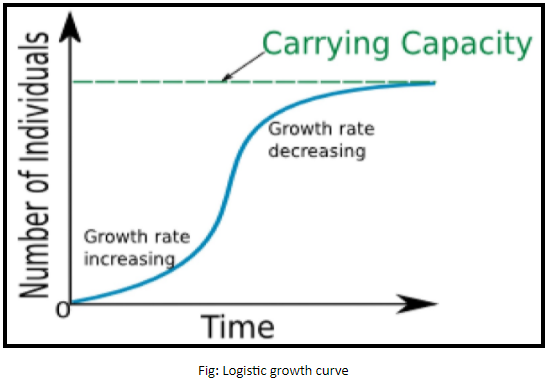
A logistic growth curve depicting a population that is limited by a definite carrying capacity is shaped like the letter:
(a) J
(b) L
(c) M
(d) S
Answer
510.2k+ views
Hint: A population is ever-changing and its growth refers to the change in the number of individuals in a population with time. A logistic growth curve represents a population limited by factors like space and food.
Complete answer:
A population represents a unit of biotic community with a near-permanent group of species occupying space at a particular time and interbreeding freely. The density of population in given habitat changes due to fluctuations in basic processes like natality or birth rate, mortality or death rate, immigration, and emigration.
Population growth can be exponential growth or logistic.
In a population, the resources can never be unlimited for a longer time, and thus as a population density increases, each individual has access to fewer resources. It means a particular environment can only support a maximum population size which is defined as its carrying capacity. With time and space, there may be environmental resistance to population growth in terms of climatic conditions, predation, and competition and that’s when growth eventually slows down. An S-shaped curve graphically represents a logistic growth curve depicting a population that is limited by definite carrying capacity.
Additional Information:
-Population growth generally depends on factors like food availability, predation threat, weather, and competition.
-But when in a population, all members have abundant resource availability and there is an intrinsic increase in the maximum number of offspring born per individual, then one can say that the population is growing exponentially. This is also known as geometric growth
-Such a population growth model, when plotted graphically, results in a J-shaped curve. It can be obtained when population size is plotted over time.
So, the correct answer is ‘S.’
Note: -Population dispersal is the movement of individuals into or out of the population or the population area. It occurs in the three following ways:
Emigration: It is the one- way outward movement of individuals from an area.
Immigration: It is the one- way inward movement of individuals into an area.
Migration: Periodic departure and return of individuals to the same area.

Complete answer:
A population represents a unit of biotic community with a near-permanent group of species occupying space at a particular time and interbreeding freely. The density of population in given habitat changes due to fluctuations in basic processes like natality or birth rate, mortality or death rate, immigration, and emigration.
Population growth can be exponential growth or logistic.
In a population, the resources can never be unlimited for a longer time, and thus as a population density increases, each individual has access to fewer resources. It means a particular environment can only support a maximum population size which is defined as its carrying capacity. With time and space, there may be environmental resistance to population growth in terms of climatic conditions, predation, and competition and that’s when growth eventually slows down. An S-shaped curve graphically represents a logistic growth curve depicting a population that is limited by definite carrying capacity.
Additional Information:
-Population growth generally depends on factors like food availability, predation threat, weather, and competition.
-But when in a population, all members have abundant resource availability and there is an intrinsic increase in the maximum number of offspring born per individual, then one can say that the population is growing exponentially. This is also known as geometric growth
-Such a population growth model, when plotted graphically, results in a J-shaped curve. It can be obtained when population size is plotted over time.
So, the correct answer is ‘S.’
Note: -Population dispersal is the movement of individuals into or out of the population or the population area. It occurs in the three following ways:
Emigration: It is the one- way outward movement of individuals from an area.
Immigration: It is the one- way inward movement of individuals into an area.
Migration: Periodic departure and return of individuals to the same area.

Recently Updated Pages
Master Class 12 Social Science: Engaging Questions & Answers for Success

Master Class 12 Physics: Engaging Questions & Answers for Success

Master Class 12 Maths: Engaging Questions & Answers for Success

Master Class 12 Economics: Engaging Questions & Answers for Success

Master Class 12 Chemistry: Engaging Questions & Answers for Success

Master Class 12 Business Studies: Engaging Questions & Answers for Success

Trending doubts
What are the major means of transport Explain each class 12 social science CBSE

Which are the Top 10 Largest Countries of the World?

Draw a labelled sketch of the human eye class 12 physics CBSE

How much time does it take to bleed after eating p class 12 biology CBSE

Explain sex determination in humans with line diag class 12 biology CBSE

Explain sex determination in humans with the help of class 12 biology CBSE




